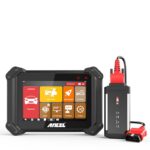Getting started with car diagnostics can feel daunting, but tools like the C110 Obd2 Scanner aim to simplify the process. As a newcomer to using OBD2 scanners, my initial experience with this budget-friendly device was quite revealing. Many online forums mention the C110 as an economical option, and my first-hand encounter confirms its potential, particularly for those taking their first steps into automotive diagnostics.
Initially, connecting the C110 OBD2 scanner to my car wasn’t seamless. It failed to communicate, which was a bit frustrating. However, diagnosing the issue led to a simple fix: cleaning the car’s 20-pin diagnostic connector. Years of grime and oxidation can build up in these ports, hindering proper connection. Using a small wooden splint, moistened with WD40, to gently clean each pin socket proved to be the solution. After this quick cleanup, the C110 scanner connected instantly, highlighting a common issue with older vehicles and the importance of clean connections for effective diagnostics.
Once connected, the first step was to run a diagnostic scan for error codes. The C110 OBD2 scanner quickly identified a code: ’70 camshaft position sensor.’ Notably, this wasn’t the standard ‘PXXXX’ code format often seen with OBD2 errors, but it was clearly indicative of a potential issue. Researching this code suggested it might be historical, meaning it was stored but not currently active. To investigate further, I used the scanner’s function to erase the code.
After clearing the code, I took the car for a drive to see if the error would reappear. Upon returning and reconnecting the C110 OBD2 scanner, I ran another scan. This time, the scanner reported ‘no trouble code!’ This was a positive outcome, suggesting the initial camshaft position sensor error was indeed a historical issue that had not been cleared previously. This simple process of reading and clearing codes demonstrates the C110 scanner’s basic yet valuable functionality in identifying and managing potential car problems.
Beyond basic error code reading, the C110 OBD2 scanner also offers a live data stream feature. The instructions indicated that the scanner should be connected before starting the ignition. However, following these instructions resulted in a blank screen on the scanner once the engine started. Experimenting a bit, I found that connecting the scanner while in DTC (Diagnostic Trouble Code) mode, and then starting the engine, allowed the live data stream to function correctly. This revealed seven screens of real-time data from various sensors, with options to display graphs for many parameters.
While interpreting all the sensor readings requires further learning and familiarization, some values were immediately understandable. Many readings fluctuated in real-time, reflecting the engine’s operation. This live data capability of the C110 OBD2 scanner opens up a significant avenue for learning about vehicle systems and potentially diagnosing issues as they occur. For anyone starting out with car diagnostics, the C110 OBD2 scanner provides an accessible and functional entry point. Its ease of use for basic tasks like reading and clearing codes, combined with the more advanced feature of live data streaming, makes it a valuable tool for DIY car maintenance and understanding your vehicle better.

